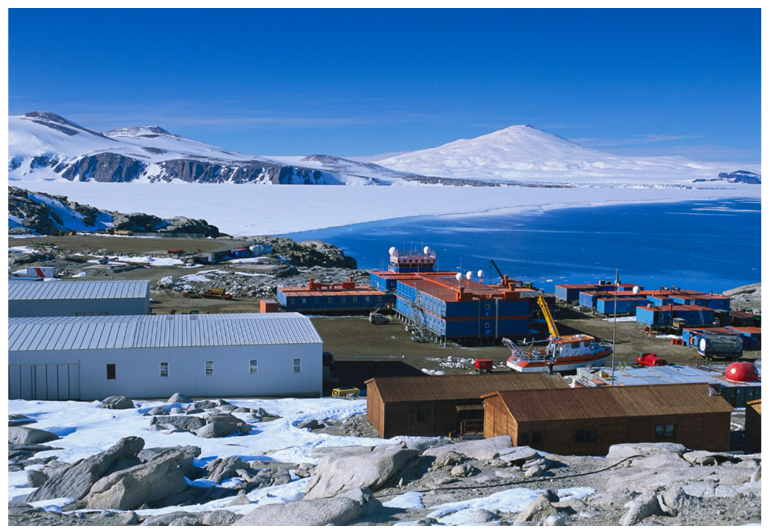Mario Zucchelli Station, IT

Mario Zucchelli Station, IT
Mario Zucchelli Station (MZS) is one of two Italian stations in Antarctica. Located on the Ross Sea coast, it is open only during the southern summer, from mid-October to mid-February.
The station has been active since 1985 with the support of the National Antarctic Research Program (PNRA). Its operations and logistics are currently managed by ENEA (Italian National Agency for New Technologies, Energy and Sustainable Economic Development), while the CNR (Italian National Research Council) is responsible for coordinating and planning scientific activities. Both logistics and scientific activities are defined based on a three-year strategic plan and annual executive actions, prepared by a Commission (CSNA) established at the Ministry of Research (MUR) with the support of CNR and ENEA.
It is located in Terra Nova Bay, along the northern coast of Victoria Land, 15 meters above sea level. Equipment and personnel can be transferred by air (at the beginning of the season) and subsequently by sea. The station has laboratories equipped for chemical, biological, and geological analysis, a specially equipped aquarium, mechanical workshops, and an electronics laboratory. The station has an optimal capacity of 80-85 people, with a maximum capacity of 120-125 beds. Researchers have access to the sea and surrounding territory both by land and by helicopter.
Observatories: MZS has an astronomical observatory and other permanent observatories to study terrestrial magnetism, the ionosphere, seismic movements, tides, geodetic references, and meteorological variables.
Contribution to POLARIN key research challenges: 1, 2, 3, 4, 5.
Contact:
Maurizio Azzaro maurizio.azzaro[at]cnr.it
Vito Vitale vito.vitale[at]cnr.it
Website address:
https://www.polarin-gis.org/Home/Station/114
www.pnra.aq/stazione-mario-zucchelli
https://polardex.org/ (search for Zucchelli)
https://static1.squarespace.com/static/61073506e9b0073c7eaaf464/t/61562eb485b96b118de9f207/1633038006857/Italy_Antarctic_Station_Catalogue_Aug2017.pdf
Location
MZS is located in the Ross Sea area, in the Victoria Land, at the foot of small range called Northern Foothills. MZS is a costal station built on a granite promontory overlooking the Gerlache Inlet, within the wider Terra Nova Bay.
Facilities
The station is built right on the shore, on a granite rocky peninsula with a north-south orientation. The area assigned to the buildings provides easy access from/to the sea from both east and west. The small inlet on the east shore is particularly suited for unloading cargo at the beginning of the season, when the sea is totally covered with ice. The fast-ice in Tethys Bay is used at the beginning of the season as an aircraft landing place. The main facilities are runways, helipads, plants (power production, incinerator, waste water treatment, desalinator, liquefier), fuel storage and acquarium.
Area under roof: 7500 (m2), Area scientific laboratories 2400 (m2)
Type of scientific laboratories: Astrophysics, Biology, Chemistry, Climate, Geodesy, Geology, Geomagnetism, Geophysics, Glaciology, Gravimetric, Ionosphere, Scientific diving, Seismology. conference room.
Capacity: number of beds 124, number of staff on station (peak/summer season) 80, number of scientists on station (peak/summer season) 40.
Services offered
Access to the site, lab space (cfr. above), mechanical workshop, carpentry, electronic lab, storage space communication services. Possibility to move around the station by foot and/or with vehicles following well-defined safety procedures. Possibility to cooperate with long-term observation activities as well as ongoing projects.
What is included in the Access
Unit of access: User/day
Modalities of access offered: In-person access, remote access
The cost indicated is all-inclusive (use of all facilities and any needs during the field campaign) starting from the Antarctic Hub of Christchurch (NZ) and return. Alternatively, the hub could be Australia (Hobart). The typical duration of work is 15 days. We expect that proposals could include in general 2 pax. TA will be included in the annual plan for the Italian activity in Antarctica and will be equal to any other research activity in terms of access to infrastructures and logistical support.
Availability for Access
See the table in the dedicated Transnational Access call page.
Time frame for access preparations
Annual plan for science activities is defined during spring. Process involve scientific (CNR) and logistic (ENEA) operators. The final plan is approved typically in May, beginning June by the National Antarctic Commission for Antarctica (CSNA). To better secure resources for POLARIN, CNR will operate to obtain yet in the previous fall an approval that all resources offered in the TA call will be at disposal during thespring discussion. So the spring disccxussion will be devoted to define the
details of project participation: number of researchers, period in Antarctica, how to reach and return from Antarctica, special requests/use of base facilities, amount of transported material.
Deadline to receive all information for this detailed plan, can be fixed to end of April. Meanwhile the period May-July can be the timeframe to define all the logistic details, integrating the TA project in the frame of the whole planned science activity.
Permits, licenses and training
Depending on research activities should be carried out, request for Ethical of Environmental impact declarations can be requested to researchers by PNRA. In any case PNRA will manage the interaction with AT and/or SCAR offices devoted to check that planned activities are respectful of the environmental and ethical rules for Antarctica.
Medical guidelines
Medical health check is a pre-requisite. Italian Antarctic Program accept as valid:
– Certification on health status provided by another Antarctic program.
– Medical certification/clearance provided by researchers. In this case a specific list of required documentation will be provided by the PNRA medical officer. List being based on the standard PNRA protocol for access to Mario Zucchelli station.
– Personal information, as well as logistical details are requested and manage only after Medical health check is positive.
– Participants will receive from PNRA all dress and material necessary to operate in Antarctica. This material will be than recovered by PNRA at the end of the Expedition.